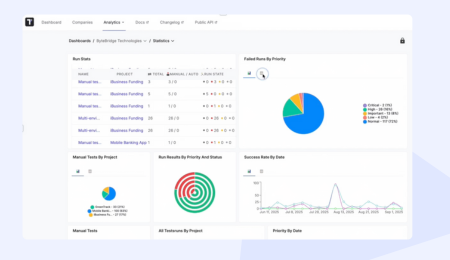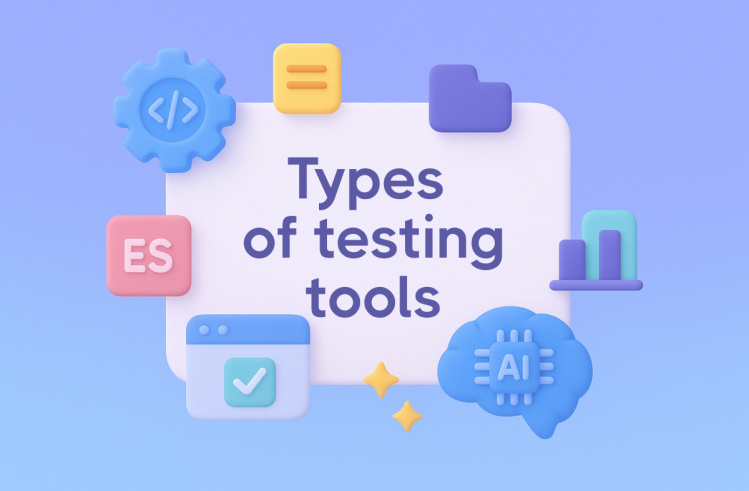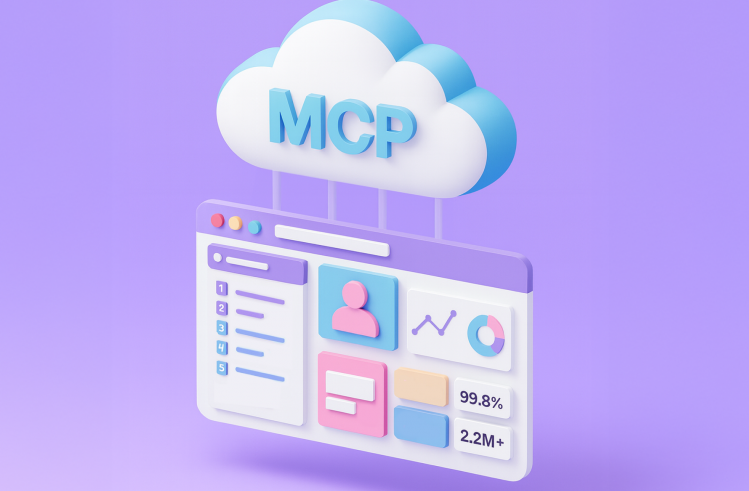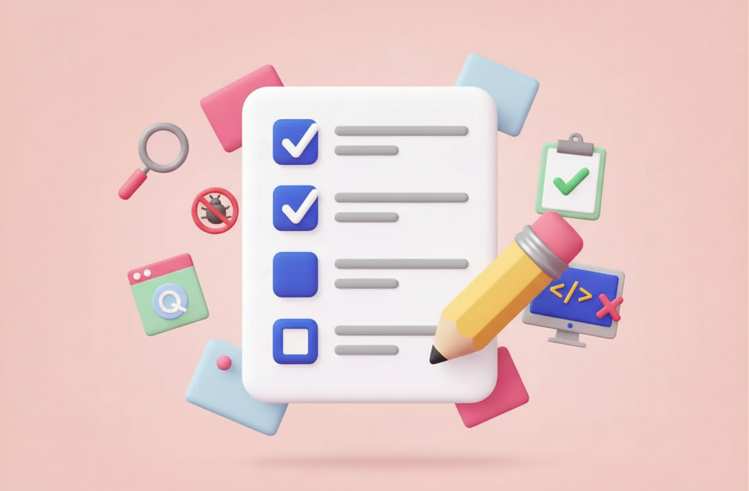Today, around 86% of software developers worldwide use the methodology of Agile and its testing – this indicates a fundamental sense in this approach to software creation. Such widespread support for the methodology is not just a number but a vivid indicator of the transition to a new era of efficient and agile software development.
This breakthrough became possible thanks to the key role Agile testing plays in ensuring accuracy and rapid adaptation to changes. That is why it has become an integral part of the modern development process. To move confidently in the new programming environment, it is important to understand the impact and value of this approach.
What is Agile Testing?
Agile testing is a software testing method based on the principles of Agile development. The testing process involves not only Agile testers but also all team members, including analysts, developers, and other specialists within their areas of responsibility. Unlike the classical approach, where testing is a separate phase, here it is integrated at all stages – from requirements gathering to design, writing new code, and creating test scenarios.
This approach is characterized by flexibility and continuity: testing is conducted throughout every cycle of the software product development. Its main goal is to meet the customer’s needs, which is achieved through constant verification of the product’s compliance with end-user expectations.
Agile testing is usually informal, conducted regularly within each iteration of the software development life cycle, and aimed at maximally considering user requirements at every stage.
The concept of Agile Testing Methodology
Agile testing methodology refers to the approach and set of practices applied to test software in an Agile development environment. In this approach, testing is not separated as a distinct phase but is organically integrated into all stages of the software product life cycle.
Its principles are outlined in the Agile Manifesto. It focuses on collaboration, adaptability to change, and continuous feedback.
Agile testing, in its essence, is a testing process conducted in the context of the Agile environment. While many types of testing — such as regression or functional testing — are also common in other development approaches, in Agile teams, the very methodology of their execution changes. This includes how testing is planned, integrated into the release cycle, and how its effectiveness is assessed.
Traditional Testing Method VS Agile Software Testing
To avoid situations where software breaks⛓️💥 during real user operation, testers are the first to try to identify all its weak spots — and pass them on for improvement.
In the classical waterfall model of software development, the process looks like a sequential chain:
Requirements Gathering → System Design → Implementation → Integration and Testing → Deployment → Maintenance.
In this approach, each subsequent stage begins only after the previous one is completed. Because of this, the QA team receives the product for testing only at the final stages of development. Errors detected at this stage are much harder and more expensive to fix than during earlier phases.
When testers are involved only at the end of development, they do not have the opportunity to ask important questions or conduct full-scale testing, as they receive almost no feedback from either the clients or the rest of the team. Sometimes, they are even perceived as an external element. In such cases, testers simply wait until the product reaches them through the production line, and only then do they test it — having limited tools to determine whether it should be sent back for revision.
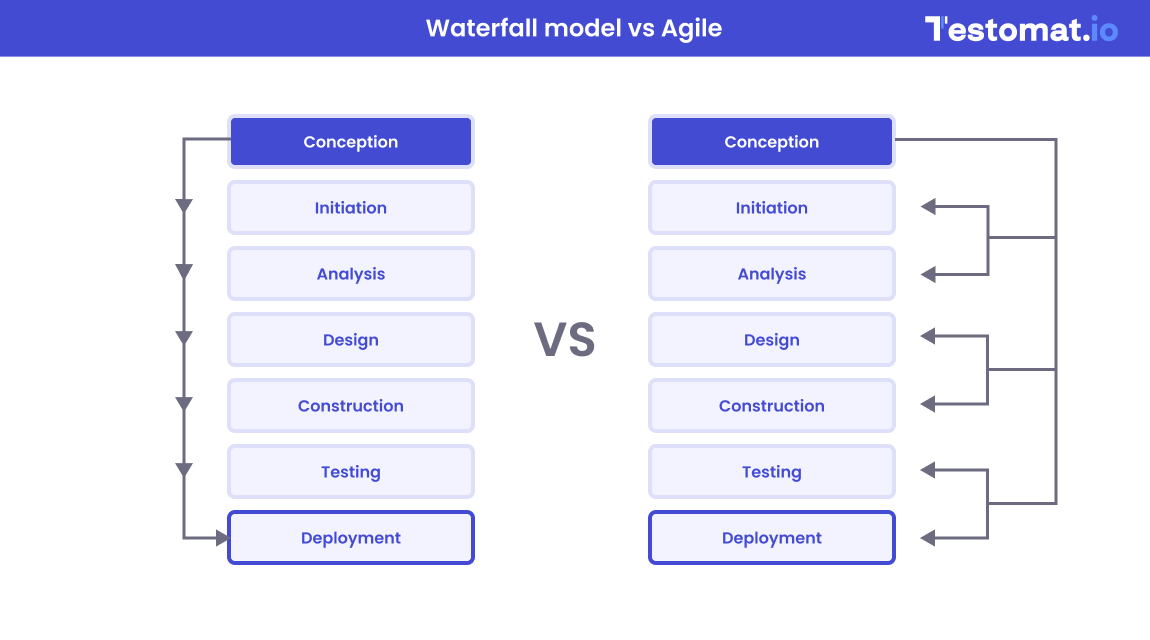
In Agile development, the approach is completely different: the test plan accompanies the entire product creation cycle. Each time the code is updated, the test team immediately gains access to it, checks it, and provides feedback directly to the developers. These short testing cycles may also include automated testing and the participation of real users, which allows for the quick detection and correction of flaws. Let’s total briefly with a table, compare the Waterfall Model and Agile once again:
| Waterfall | Agile | |
| Requirements | Clearly-defined | Can change |
| Client involvement | ||
| Type | Straightforward | Complex projects |
| Time frames | Strict | Loose |
| Team collaboration | Moderate | Intensive |
Implementing Agile testing methodology requires focus and responsibility; however, the results can significantly improve product quality. At the same time, a careless application of the Agile approach without evaluating its appropriateness can do more harm than good — leading to an unstable and unreliable system.
Here are situations when it is worth considering whether Agile testing is truly appropriate:
❌ Clearly defined project scope
If the project requirements are final and not subject to change, the dynamic nature of Agile may not provide additional value.
❌ A single influential customer
In projects where one person or a small group makes all decisions, the collaborative model of Agile may conflict with centralized decision-making according to customer requirements.
❌ Insufficient level of competence
Since Agile testing demands broad knowledge and the ability to work at a fast pace, teams without adequate preparation may find traditional approaches more comfortable.
❌ Customer insists on waterfall
If the client expects a traditional development and sequential staged approach (waterfall model), Agile may cause resistance and misunderstanding.
Agile Testing Principles
Twelve principles were formulated after the creation of the Agile Manifesto. They serve as a practical guide for teams that aim to work in accordance with the Agile philosophy. These principles help evaluate how well the team’s current actions align with the spirit of Agile and demonstrate how this approach should be implemented in everyday work.
Here is a brief summary of the key principles:
- Early and frequent testing. The earlier errors are detected, the easier they are to fix. That is why testing should start as early as possible—even during the requirements gathering phase.
- Test automation. Creating automated scripts allows for faster verification of changes. However, it is important not to overestimate the capabilities of automation and not to expect a higher level of automation than is realistically achievable.
- Continuous feedback. A tester’s task is not only to find bugs but also to ensure fast communication of test results between the client and developer to quickly improve the product.
- User value comes first. Although this is not the first item on the list, focusing on delivering value to the client is the main goal of the entire development and testing process.
- Live communication. Testers should interact directly with developers and users — this reduces the risk of errors and misunderstandings.
- Simplicity is efficiency. A tester should perform only necessary checks, but not overlook any critical ones. In product work, simple solutions are preferred if they provide maximum benefit.
- Continuous improvement. Agile professionals constantly seek new ways to make their work better and more productive.
- Adaptability to change. Agile teams quickly adapt to new conditions — whether it’s changing requirements, user feedback, or market dynamics.
- Self-organization. Testers do not wait for instructions—they independently identify where their involvement is needed and unite the team around solving the problem.
- Focus on the end user. People are the priority. Communication, convenience, and practicality are critical.
- Daily collaboration with the business. Developers and business representatives should work side by side every day to better understand customer needs and quickly implement changes in the product.
- Regular reassessment of work. The team should periodically reflect on their approach, seek improvements, and adjust behavior to achieve greater effectiveness.
Agile Runs on Continuous Feedback
Customer Feedback and Close Collaboration with Them – Above All!
The agile approach to testing values customer needs above the company’s internal requirements.
Testing throughout the entire development process results in a higher-quality product and ultimately greater customer satisfaction.
Instead of the client receiving a pig in a poke at the end, where problems may arise that are difficult (or even impossible) to fix, the agile approach allows the detection of failures and issues as they occur.
The customer plays a much more active role throughout the entire development process. The role of collaboration with clients in agile testing is much more significant than just negotiating contract terms. They can provide their suggestions and feedback at every stage. This allows tailoring the product to the customer’s needs and expectations, which leads to a much better outcome.
Agile methods may either include the end user as a full member of the team (who attends all meetings and monitors goal achievement) or involve them periodically for product demonstrations. Although some clients may not care how exactly your product is created, absolutely everyone expects a result that satisfies them.
Thus, the agile process provides transparency that no other approach can ensure since clients are involved in the development process from start to finish.
Agile Testing Life Cycle
The Agile Testing Life Cycle (ATLC) is the process QA teams follow to plan, implement, and execute testing in Agile software development environments. Agile testing is continuous and iterative, happening in each sprint.
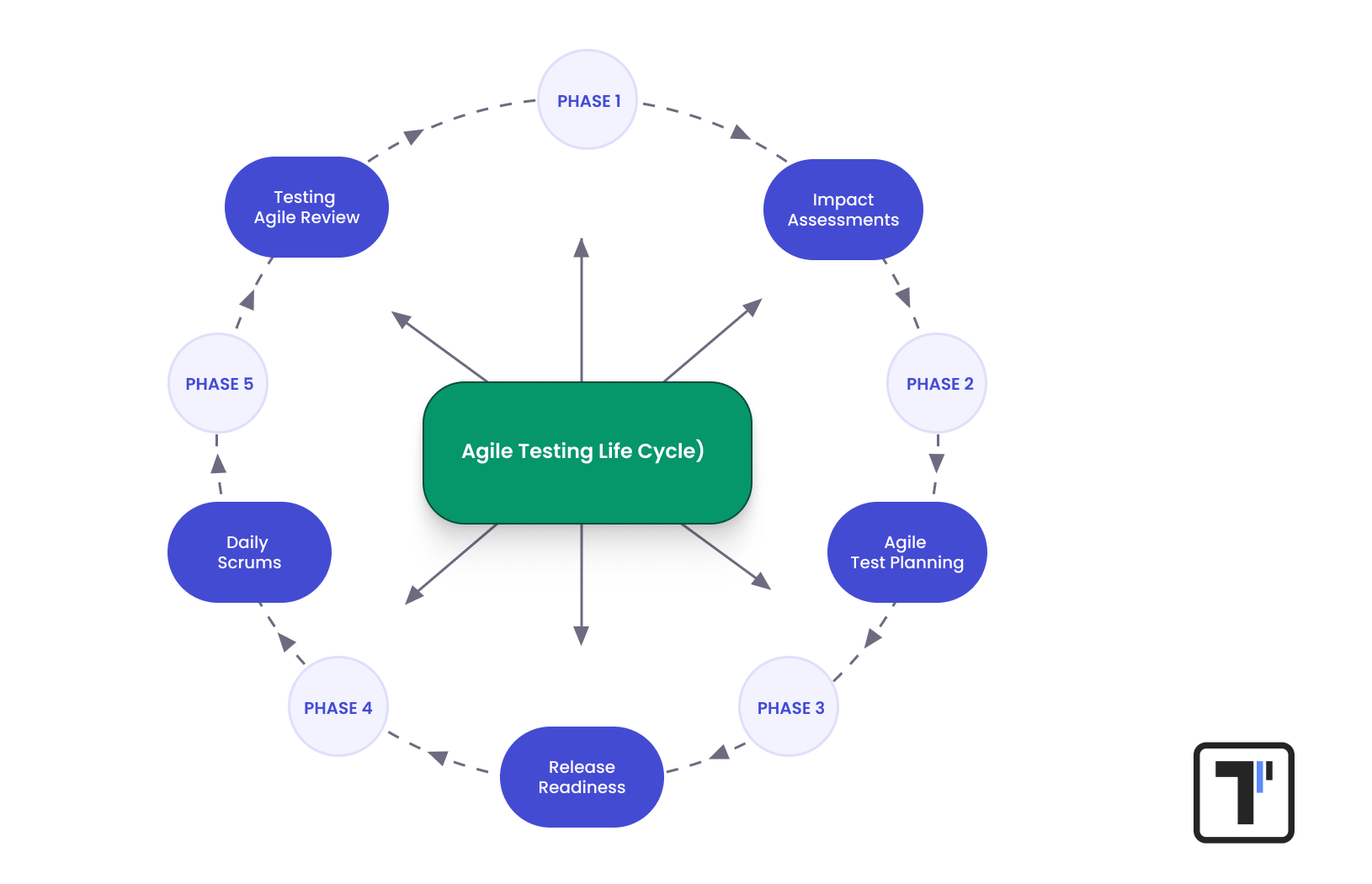
The Agile testing life cycle consists of five main stages:
- Impact analysis, Requirements Gathering. This initial stage is also known as the feedback phase. Opinions and feedback from users and stakeholders are collected. This allows testers to clearly define the goals for the next testing phase.
- Agile test planning, test design. At this stage, the testing efforts of developers and testers are combined with the input from customers and stakeholders to create a detailed plan: the testing schedule is discussed, the frequency of meetings is determined, and the expected results are defined.
- Release readiness check. At this stage, testers analyze the implemented features to determine if they are ready for launch. Functionality that does not meet quality criteria is sent back for revision to the previous development phase.
- Test Execution. As development proceeds, tests are run continuously — both manually and automated tests through CI pipelines. Automated regression, functional, and unit tests are executed with each code change.
- Daily stand-ups (Daily Scrums). Every morning, the team holds brief meetings to align on the current testing status and set goals for the day. This helps to respond quickly to changes and improves coordination.
- Agile test evaluation. The final stage includes weekly meetings with stakeholders, during which progress is analyzed and actual results are compared to the planned objectives.
Agile Testing Strategies tailored for AI-assisted testing
If you are confident that Agile testing aligns with your development team’s goals, client expectations, and product characteristics, follow these recommendations:
✅ Choose the appropriate methodology
Determine which of the Agile approaches (e.g., Scrum, Kanban, or Extreme Programming) best suits the needs of your project.
✅ Build an effective testing strategy
Focus on the four testing quadrants to cover all key aspects of product verification. We are talking about it ahead.
✅ Define objectives with AI in mind
Identify areas where AI can provide the most value — like generating test cases automatically or test data, optimizing regression tests, maintaining tests, detecting flakiness or blind spots in your testing project. Select AI-powered test platforms or AI testing agents.
✅ Ensure team collaboration and avoid tester isolation
- QA team should work closely with developers. Constant communication facilitates quick responses to changes and helps form a unified vision.
- Adhere to iteration-based work. Collaboration at each stage helps establish effective interaction from the very beginning of the project.
- Define a human-AI collaboration approach. Clarify how human testers work alongside AI — reviewing AI-generated tests, approving AI suggestions, or AI-generated insights of release readiness.
- Provide feedback. Tester comments and suggestions are important for both developers and customers. This enables two-way communication and improves the final product.
Here is a structured breakdown of the key steps within a testing strategy, which can be applied to implement Agile successfully:
#1: Iteration 0
This is the very first step in the testing process, during which the foundation is laid for all further work. At this stage, the testing environment is configured. This phase includes performing preparatory tasks:
- searching for test participants
- preparing the necessary materials and resources for usability testing
- justifying the project from a business perspective
- defining boundary conditions and the overall scope of work
- formulating key requirements and usage scenarios
- outlining one or more possible project architecture options
- outlining how and when tests will be executed—manual, automated, scheduled in pipelines
- planning the initial project budget and estimating costs
- choosing testing tools
- identifying potential risks.
#2: Construction Iteration
This is the second phase of the testing process, which is the main and most labour-intensive. It consists of a series of repeated cycles (iterations) aimed at gradually building and refining the software product. This process is divided into two types of testing:
First, Confirmatory Testing — verifies that the system meets stakeholder requirements as communicated to the team at that time. It is performed by the development team itself and is further divided into two subtypes:
- A. Agile Acceptance Testing. This is a combination of acceptance and functional testing. It can be conducted either by the development team or the stakeholders. On this stage, testers often work following test design techniques like boundary value analysis, equivalence partitioning, state transition, or BDD scenarios.
- B. Developer Testing. This is a combination of unit and integration testing that checks both the software code and the database structure.
Second, Exploratory Testing identifies problems that were missed or overlooked during confirmatory testing. In this type of testing, the tester identifies potential problems in the form of defect stories. It focuses on areas such as integration testing, load testing, security testing, and stress testing.
#3: Analysing Testing Efforts
Define defect tracking, reporting, and analytics tools, including AI-powered anomaly detection tools; how issues will be triaged, prioritized and notified to the team.
#4: Release End Game
This phase is also known as the transition phase. It includes full system testing and acceptance testing. To complete the testing stage, the product undergoes even more thorough checks than during the development iterations. Testers work on fixing identified defects. This phase includes the following activities:
- Training end users.
- Preparing support and operations staff.
- Marketing activities related to the product release.
- Backup and data recovery procedures.
- Finalization of system and user documentation.
#5: Production
This is the final phase of Agile testing. At this stage, the product is finalized after all identified defects and issues have been resolved.
Agile Testing Quadrants
Agile testing is divided into four quadrants, each covering a separate area of the software verification process.
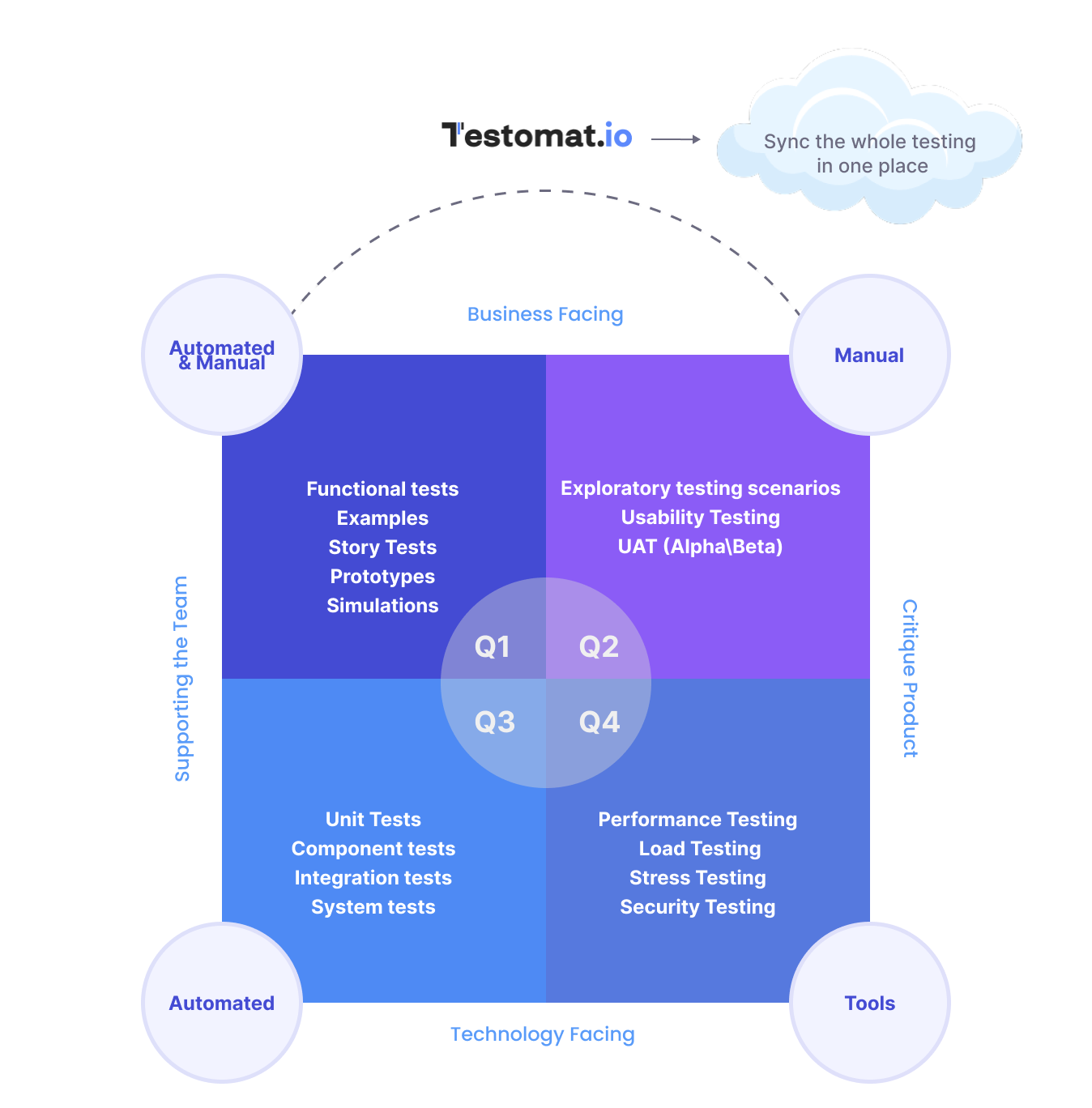
Quadrant 1 (Automated)
This stage focuses on the internal quality of the software code. Technically-oriented test scenarios are created and executed here, primarily automatically by QA testers. The main goal is to ensure the technical stability of the code.
Types of testing performed at this stage include:
- Unit Testing – checking individual functions or code fragments for correct operation.
- Component Testing – analyzing larger blocks of functionality that combine multiple parts of code working together.
Quadrant 2 (Manual and Automated)
At this stage, the emphasis is on business requirements, which testers receive from the customer both before and during development. User-oriented scenarios are created and executed either manually or through automation.
This quadrant includes the following types of testing:
- Pair testing – two specialists test the software simultaneously, exchanging ideas for faster error detection.
- Scenario and workflow testing – verifying whether the program’s behavior aligns with business requirements.
- Verification of user stories and prototypes – assessing whether they meet the expectations of future users.
Quadrant 3 (Manual)
The third stage provides feedback for the first two. Testing is conducted in several iterations, after which the team improves the code. Although this stage is often associated with preparing for automation, the process itself is mostly manual.
This quadrant includes:
- Usability Testing – evaluating the intuitiveness and ease of use of the interface.
- Collaborative Testing – close interaction between testers, the development team, and stakeholders.
- User Acceptance Testing (UAT) – verifying whether the product meets the expectations and needs of end users.
- Pair Testing with Customers – working side by side with clients to quickly gather feedback.
Quadrant 4 (Tools)
The final stage focuses on verifying the non-functional characteristics of the product, particularly its reliability, security, and performance. Specialized tools are used here for in-depth analysis.
This quadrant includes:
- Security analysis
- Scalability testing
- Infrastructure verification
- Data migration assessment
- Non-functional testing – including load, stress, and performance testing.
These four quadrants allow for coverage of both functional and non-functional aspects of development, ensuring comprehensive testing in an Agile environment.
5 Key Types of Testing in Agile
Several approaches have been developed for implementing Agile testing, each offering its own advantages depending on the context of the project. Below are four of the most popular methodologies actively used today. Although none of these methods are universally applicable, they serve as an effective foundation for building a custom-tailored testing strategy.
Test-Driven Development
In this approach, test cases are created before writing the main code. The methodology includes three sequential stages:
- defining what exactly needs to be tested
- forming a user story
- creating a unit test
- writing the code that allows the test to pass;
- refactoring
This process ensures that every part of the code is tested and improved gradually in clearly controlled steps.
TDD is typically applied to unit and component testing, which is often automated using specialized tools. This approach helps ensure that the functionality is implemented correctly and meets the requirements.
Acceptance Test-Driven Development
ATDD is a variation of the TDD (test-driven development) approach, which enhances team collaboration in an Agile environment. Here, clients, developers, and testers jointly define acceptance tests, focusing on customer needs. Only after these tests are created does the team proceed to develop functionality, which ensures a clear understanding of requirements and minimizes the risk of errors. Afterward, functional tests are conducted.
Acceptance testing highlights:
- requirements are very clearly analyzed without any ambiguity
- acceptance tests serve as a guide for the entire development process
- encourages collaboration among cross-functional team
In addition, this approach simplifies the creation of test scenarios and allows developers to better understand user expectations, reducing misunderstandings in the process.
Behavior-Driven Development
This is a logical continuation of the TDD and ATDD approaches, focusing on achieving expected business outcomes. At the core of this method is describing system behavior in language that is understandable to all project participants. Testing is performed according to described user behavior scenarios.
The BDD process includes five main steps:
- Formulating expected behavior.
- Writing the scenario steps.
- Running the test with the expected failure.
- Implementing the functionality to pass the test.
- Retesting until success is achieved.
Uncover specifics
Exploratory Testing in Agile
This approach involves continuous learning during testing: the tester simultaneously creates and executes tests, analyzes the results, and plans further actions based on them. Exploratory testing is not based on predefined scripts — instead, it allows for a creative approach to discovering bugs that traditional testing might miss. This method makes it possible to flexibly assess the product’s working condition and how it will behave in real use.
Session-Based Testing
This approach extends and structures exploratory testing by providing it with clear boundaries. To avoid chaos, each testing session begins with defining a clear objective (a charter), after which the tester focuses solely on its completion for a limited time.
The results of each session are documented, and the tester reports to the lead afterward. Such structure ensures that no part of the product is overlooked and allows for effective progress management in testing.
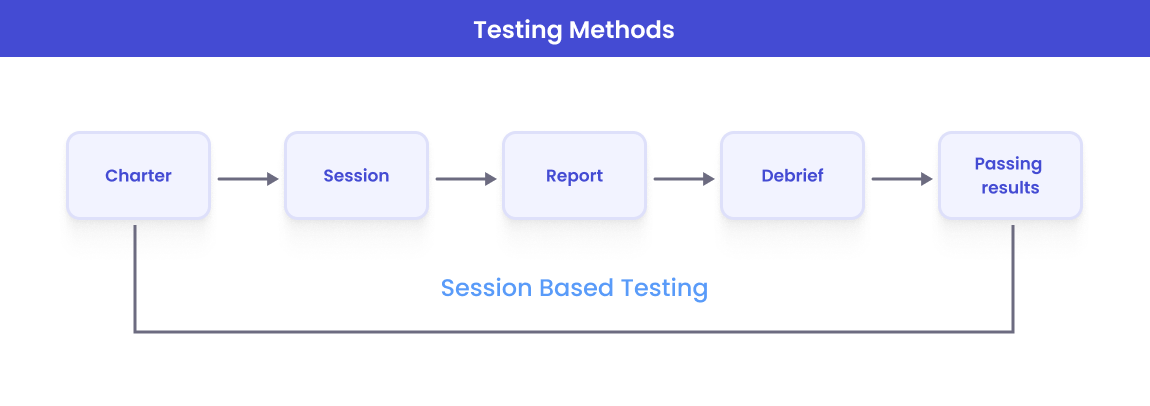
Agile Testing Supports Continuous Testing
Agile testing is based on the idea that continuous verification is an integral part of development and is as important as writing code. Within Agile methodologies, testing is tightly interwoven with the development process, allowing bugs to be identified at early stages and on a regular basis. This approach enables testers to detect issues throughout all stages of product development, significantly speeding up its release readiness.
By combining continuous integration and continuous delivery with flexible testing approaches, development teams can ensure that their software product is always ready for release and can easily adapt to any changes or new market demands.
Agile-focused testing practices – building resilience and optimizing team output.
Thus, the continuous testing inherent to the agile method allows creating a product that is both high-quality and fully meets the customer’s expectations.
Advantages of Agile Testing
Implementing Agile testing brings three simple yet significant benefits: a satisfied team, a higher-quality product, and faster time-to-market. This Ideal Trio is a strong argument for building an effective Agile testing strategy.
1️⃣ Higher-Quality Product
Thanks to continuous feedback, Agile allows errors to be detected early in development. Testing is launched simultaneously with code writing, so bugs are eliminated immediately rather than accumulating until the final stage. Each product iteration undergoes a complete cycle of testing and improvement. Continuous verification and close collaboration among stakeholders facilitate a better understanding and the development of a truly high-quality solution.
2️⃣ Fast Delivery
Unlike the waterfall model, where months or even years can pass between development and launch, Agile allows this gap to be significantly reduced. The product is gradually improved during the development process, guided by regular user feedback. This helps to quickly adapt to market needs and deliver the solution to end users in the shortest possible time.
3️⃣ Happier Team
The final principle of Agile testing is job satisfaction. Constant interaction among team members creates an atmosphere of collaboration, trust, and mutual support. This approach not only boosts productivity but also makes the workflow more comfortable and inspiring.
As Lisa Crispin and Janet Gregory noted:
“A team that guides itself with agile values and principles will have higher team morale and better velocity than a poorly functioning team of talented individuals.”
Transition to Agile Testing
Remember, every company is its own separate world, so the path to agile thinking will be unique for each. Therefore, don’t be afraid to improvise and adapt everything to suit yourself!
Communication within the team and working side by side – that’s everything for us!
In Agile philosophy, the main thing is people. It is they, living people, who respond to business needs and essentially steer the development process. Therefore, if we want to cultivate agile thinking for testing, it is extremely important that everyone’s voice is heard.
Agile is all about ensuring the client is satisfied by receiving software that works without long pauses.
And for that, testers need to learn not to stay silent but actively communicate. Because the goal is the same for everyone – to create a truly great product and provide users with best practices.
Forget about those times when departments sat in their own “cubicles” and everyone was on their own. If we choose the Agile path, communication is alpha and omega. Agile requires the team to work as a single organism, not that each tester is by themselves or each department works alone.
Quality is the shared responsibility of the entire team, not just the tester.
When everyone is together as one team, this not only helps to achieve the main goal – to deliver a valuable product to the user – but also protects against delays in work.
Moreover, such an approach allows squeezing the maximum from the process: to find product defects faster and, most importantly, to work proactively, preventing problems rather than just fixing them afterward.
What Agile Teams Need to Run Like Clockwork?
- Have clear common goals and intelligently distribute work among teams (if there are several). This provides autonomy and ensures that no one duplicates the same work, creating unnecessary dependencies.
- Remove walls between departments. To succeed in the agile transition, it may be necessary to reconsider the usual communication culture and even the company structure to support teamwork.
If you manage to successfully transition to agile rails, there will be many advantages. And by developing an agile mindset and implementing agile processes, these advantages can be fully realized.
What might come in handy to establish an Agile testing process?
→ Tools for collaboration and integration.
→ Visual boards (so everyone can see what’s going on).
→ Short Daily Stand-ups between teams.
→ Joint release planning for all teams.
Learn to Change and Develop Agile Quickly
▶️ Training
Perhaps the best way to smoothly transition to agile rails is to undergo proper training. If you want yourself and your team to develop the right agile mindset for testing, good training will help a lot here.
Unlike what testers of the “old school” might be used to, agile testing is not about final checks before release or just bug hunting. It happens continuously, is woven into the development process itself, and does not wait for the finished product.
Why so? Because agile testing is primarily a tool for preventing problems, not just detecting them. It helps improve individual parts of the product and the testing approaches themselves. Therefore, training will be useful for everyone who wants to move to Agile.
🔄 Fast feedback
The agile process also relies on fast feedback, which we have known already. Since the product is tested continuously, testers need to learn to respond instantly and adapt – this is the key to a successful transition.
Continuous testing requires changes: in people, in processes, in technologies. Therefore, cultivating an agile mindset to implement these changes is extremely important.
As part of development, automated tests that provide quick feedback considering risks are critically important in Agile. When testing is integrated into the development process, the team can be more confident that the user experience is reliably protected.
🆗 Focus On a Working Product, Not Mountains of Documentation
Usually, when software products are created, there is an attempt to document them thoroughly for development and delivery.
Creating all this paperwork can take a lot of time because the list of necessary documents is quite large: technical specifications and requirements, interface design documents, documentation and testing plans.
The time and attention consumed by this documentation often cause delays in development. Although documentation is still needed in Agile, the approach to it is simplified to avoid such slowdowns.
Besides, the tester can focus more on the software itself and on those actions that truly add value and, as a result, make clients happy.
Smart documentation plays an important role in agile testing, allowing the focus to remain on the end product.
In agile projects, the test plan is usually very concise, so it is recommended to supplement it with a strategy describing exactly how the system should be tested. This follows from how agile projects function, especially the fact that testers work in short cycles (iterations).
Documents commonly used in Agile testing may include:
- Test strategy (how we will test the system)
- Test plan (concise)
- Checklists for setup and regression testing
- Test specifications.
- Ideas for exploratory testing
- Test logs and lists of found issues
Responsibilities of an Agile Tester
An agile environment requires that a typical Agile testing professional has to meet the following traits:
| Trait | Description |
| Testing sense | Attitude to break software. |
| Soft Skills | An Agile tester should easily interact with colleagues, establish effective communication with both Dev specialists and the business. Clearly and effectively conveys findings, risks, and feedback within the team. |
| Ability to learn new things | Analytical Skills. Constantly updates different technical skills. |
| Hard Skills | Experience using various testing tools and techniques, including technical knowledge and skills in automation tools, understanding and practice of exploratory testing, e.g. |
| Adaptability | Openness toward changeness. Quickly adjusts to changing requirements and priorities. |
| Curiosity | Eager to explore, ask questions, and understand deeply. |
| Attention to Detail | Carefully analyzes requirements, test cases and results. |
| Ownership | Takes responsibility for testing quality and drives improvement efforts. |
| Problem-Solving | Identifies root causes of issues and works creatively to resolve them. |
| Result orientation | Desire to achieve goals. Genuine interest in creating value for the business. |
Conclusion
The Agile methodology has gained wide popularity as an effective approach to project management not only in software development but also in many other fields. Its natural flexibility and ability to respond promptly to changes make this model one of the most relevant in today’s world.
With proper implementation and sincere commitment of the team to its principles, Agile can provide numerous benefits and allows teams to remain flexible, resilient, and productive even under challenging conditions.
Frequently asked questions
How does Agile testing differ from traditional testing methodologies?

Agile testing is integrated into the development cycle rather than performed after coding is complete.
-
Traditional (Waterfall): Testing happens in a separate phase, often leading to late discovery of defects.
-
Agile: Testing is continuous and collaborative — testers work closely with developers, product owners, and sometimes end-users. Automated tests, exploratory testing, and quick feedback loops are critical to ensure quality at speed.
What are the main Agile testing quadrants, and how are they applied in real projects?

The Agile Testing Quadrants help teams balance types of testing:
-
Q1: Unit-level automation for code verification (JUnit, TestNG).
-
Q2: Functional testing to validate business rules (BDD frameworks, UI automation).
-
Q3: Exploratory and usability testing for user experience feedback.
-
Q4: Performance, security, and scalability testing (JMeter, Gatling).
Real-world Agile teams often run Q1 & Q2 tests in CI pipelines, while Q3 & Q4 involve dedicated sprints or parallel activities to avoid slowing down delivery.
How can Agile teams ensure performance testing fits into short sprints?

Performance testing in Agile must be incremental and lightweight:
-
Identify key performance criteria early in backlog refinement.
-
Integrate basic load tests into CI/CD to catch regressions quickly.
-
Use shift-left performance testing — run smaller, targeted performance checks during development rather than full-scale tests only before release.
-
Reserve full-scale stress/load tests for release candidates or after major architectural changes.
